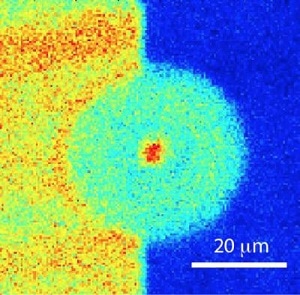Sep 1 2016
 This image shows the formation of singular charge patterns upon localized laser excitation. Credit: Harishankar Jayakumar
This image shows the formation of singular charge patterns upon localized laser excitation. Credit: Harishankar Jayakumar
Charge transport between Nitrogen-Vacancy color centers in diamond has been successfully demonstrated by a team from the City College of New York. The team, headed by physicist Dr. Carlos Meriles, created a novel multi-color scanning microscopy technique in order to visualize the charge transport.
The breakthrough experiment has the potential to lead to room-temperature quantum information processing in diamond and optical data storage in three dimensions.
The nitrogen-vacancy (NV) center is considered an optically active defect in diamond comprising an adjacent vacancy and a nitrogen atom, replacing carbon atoms in the diamond lattice. This defect comprises of electrons that store quantum information.
It is possible to use this unique property for quantum computation by developing a network of interacting NV centers. Until now, the research has concentrated on the usage photons emitted by the NV centers in order to produce this interaction under a specific low temperature environment.
As part of a complementary approach, researchers from City College have collaborated with researchers from the Australian National University (ANU) in Canberra to develop an electron-transport-based interaction that can be achieved in ambient conditions.
A focused green laser beam was used in one major experiment to remove the electrons from the NV centers, which were later radially diffused in the diamond. The NV centers that trapped the diffused charges up to 30 microns were imaged by a red laser scan.
The variation in luminescence was exploited by the researchers in luminescence intensities of the NV centers without and with the electron in order to develop a map of the trapped carriers.
These are very promising initial results.
Dr. Harishankar Jayakumar, Postdoctoral Fellow, City College of New York
Other key contributors include CCNY team members Dr. Siddharth Dhomkar, and graduate student Jacob Henshaw, as well as Dr. Marcus Doherty and Prof. Neil Manson at ANU.
The article featured in the journal Nature Communications, and discusses how difficult interactions of the charge carriers with various other faults in diamonds, revealed by this method. The research was supported by the National Science Foundation.